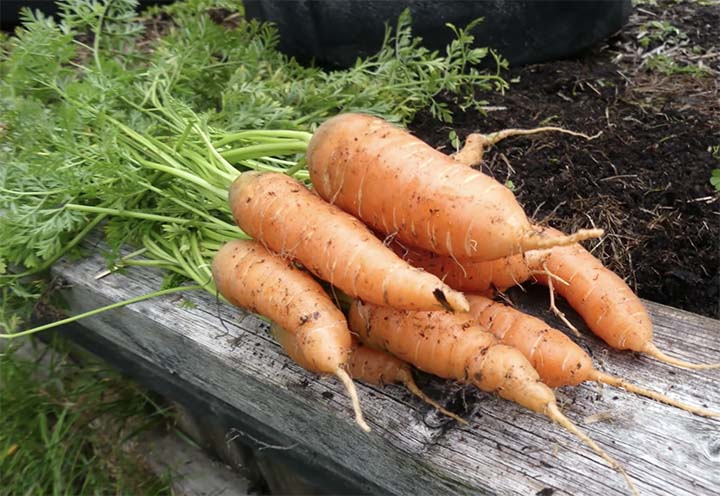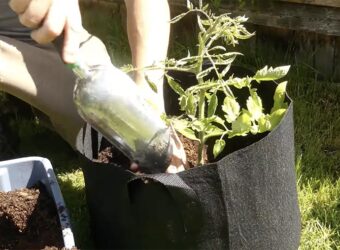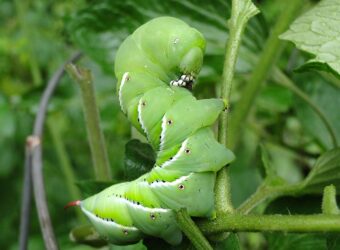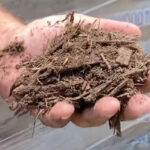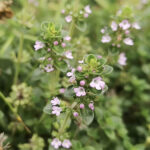Growing any of your food is rewarding, but some crops offer a bigger payoff than others. And if you ask me, carrots are one of the most satisfying vegetables to grow yourself.
First, pulling a carrot out of the garden is a rewarding experience. You plant the seeds, then wait months watching the above-ground greens grow while wondering what lies below the soil surface. Pulling the roots out of the ground allows you to uncover the reward of all your work.
And homegrown carrots designed for eating fresh have a flavor that’s heads and shoulders above the storage carrots you buy in a store. Especially if you harvest your roots after a cold snap!
Despite all the benefits growing carrots provides, mastering this crop can also be a little challenging. If you’ve ever had a carrot crop overtaken by weeds or pulled out scraggly carrots that are only an inch long, you know what I’m talking about.
Utilizing companion planting is one way you can make growing carrots easier. I’m going to dive into the benefits of practicing companion planting and then cover some of the best and worst plants to grow alongside carrots.
Why Should You Practice Companion Planting with Carrots?
You may have heard the term companion planting before and even tried to practice it yourself. But do you know what it really means?
In short, companion planting involves utilizing plants to benefit other plants. On a small garden scale, this often means placing beneficial plants close to each other or rotating crops so your plants stay healthy.
Companion planting can provide numerous benefits to carrot plants. These include improved pest control, better soil health, a more suitable environment, and weed suppression. I’ll provide a few more details about each of these benefits so you can better understand why you may want to practice companion planting.
Pest Control
Certain companion plants can help attract beneficial insects that feed on common carrot pests. Some of the most common predatory insects include ladybugs, green lacewings, assassin bugs, minute pirate bugs, parasitic wasps, and hoverflies.
While all of these insects help eliminate carrot pests like aphids, cutworms, wireworms, and carrot rust flies, not all lifeforms of these good bugs feed on the pests. Oftentimes, the larval stage feeds on the pests, and the adult form consumes pollen and/or nectar.
That means that adding flowering plants to your garden can help attract the adult forms of predatory insects and encourage them to lay eggs in your garden. When the eggs hatch, the larval forms can begin attacking pests.
Weed Suppression
Growing carrots comes with a wide range of challenges, but weed pressure is one of the top problems gardeners face. Carrots are slow-growing crops with limited foliage, which means fast-growing weeds often overtake them.
While companion planting won’t necessarily eliminate the need to pluck weeds from around your carrots, it can decrease the amount of weeds. And when it comes to managing a garden, any weed reduction is nice!
If you want to use companion planting to limit weeds, you’ll typically want to plant a crop before your carrots. For example, you can plant rye, which can kill weeds, before your carrots to give the tender roots a better chance of surviving.
Improved Soil Health
Everyone dreams of long, straight carrots that are sweet and crunchy. Yet poor soil health can lead to short and stubby roots or luscious greens with limited roots.
The plants you plant with and before carrots can impact both soil texture and nutrients, so choosing the right plants can have a big impact.
Companion planting can help loosen the soil so carrot roots have a better chance of growing deep into the ground. It can also help provide the balance of nutrients that supports the development of strong roots and greens.
Improved Environmental Conditions
Carrots typically grow better in cool conditions, but they can also be ground in the summer.
One challenge of summer-grown carrots is keeping the soil moist while the carrot seeds germinate and the roots develop. Utilizing companion plants can help shade the soil, which can limit evaporation and therefore extend the time you can wait in between waterings.
The Best Carrot Companion Plants
So we’ve established that companion plants can provide carrot plants with all sorts of benefits. Now, it’s time to dive into what specific plants work best with carrots.
Whether you’re trying to determine what to plant in the slot before your carrots or looking for plants that will be good carrot neighbors, we’ve got a plant that will fit the bill.
1. Calendula
If you’re dealing with carrot pests like aphids and carrot rust flies, one of the best control methods is attracting predatory insects like parasitic wasps and green lacewings. And calendula can help you do just that.
Calendula plants produce so many flowers that it can be difficult to stay on top of picking or deadheading the blooms. These flowers are not only beautiful and medicinal, but they’re also attractive to good bugs like wasps, ladybugs, green lacewings, and more.
When the adult forms of the insects come to your garden to feed on calendula flowers, they may stick around and lay their eggs on or near carrot pests. When the eggs hatch, the larvae can start controlling the pests.
As long as you plant calendula within 20 or 30 feet of your carrots, they should provide their intended benefits. However, you should make sure to plant calendula at least 18 inches away from carrots to allow for adequate airflow and light.
2. Sweet Alyssum
Since many beneficial insects are tiny, tiny creatures that humans can barely see, it makes sense that they tend to feed on smaller flowers than larger flowers. That’s where sweet alyssum comes in.
This low-growing flowering plant produces hundreds of small, nectar-rich flowers that insects like hoverflies and parasitic wasps love. With a food source around to support the adults, these critters are more likely to lay their eggs on or near carrot pests like aphids and carrot rust flies.
Another reason why carrots and sweet alyssum go so well together is that they both thrive in cooler weather. That means you can plant them at the same time and watch both crops flourish.
I like to plant sweet alyssum about 12–18 inches away from my carrot plants. This spacing allows for adequate airflow between the plants while not wasting usable garden space.
3. Radishes
Since carrots are so slow to germinate and grow, I like to take advantage of this slow growth to plant another crop in the same area. Radishes are the quick-growing crop I turn to most often.
Since radishes and carrots both grow well in cool weather, you can plant the seeds at the same time. I find that planting them in March–May and September–October works best.
The key to planting these crops together lies in proper plant spacing. Your goal is to utilize the carrot’s slow-growing nature to sneak in an extra crop and utilize the radish’s quick growth to shade out weeds.
My favorite method for growing these crops together is to plant alternating rows of radishes and carrots. I like to plant a row of carrot seeds and then plant a row of radish seeds about two to three inches away.
Since radish seeds germinate quickly, the radish plants will be about an inch tall by the time the carrot seeds germinate. The radishes will be ready to harvest in about three to four weeks, just as the carrots and radishes become crowded.
Growing these two crops together allows you to harvest some radishes and helps decrease the weeds between your carrot rows.
4. Tillage Radish
If you’re dealing with compacted soils, it’s unlikely that you’ll end up with beautiful carrot roots. Instead of planting carrot seeds into tough soil, you should first take steps to loosen the soil.
One way to do this is by manually loosening the soil with the help of tools like broad forks or tillers. However, you can also turn to biological methods.
Tillage radishes are a type of long daikon radish known for their long taproots and ability to break through compacted soils. Planting these radishes before carrots can help prepare the ground and provide you with a good harvest of radishes.
I recommend planting tillage radishes in the fall and then planting carrots in the same area the following spring.
5. Rye
If you have a weed-infested area where you want to plant carrots, consider planting rye.
The weed-suppressing effects of rye are two-fold.
First, this grain releases compounds that limit the growth of other plants, a process known as allelopathy. That means that weeds seeds are less likely to germinate, and weeds that germinate experience stunted growth.
Second, rye produces a large amount of biomass that you can use as a weed-suppressing mulch.
Since rye does provide allelopathic effects, it’s important to get your timing right. Killing the rye at least two weeks before you plant your carrot seeds will give the carrots the best chance of thriving.
The Worst Carrot Companion Plants
While many plants can help carrots grow well, others can hinder carrots’ growth. Avoid planting the following close to or before your carrot plants.
1. Dill
Dill produces large umbels of yellow flowers, which may lead you to believe this plant can benefit carrot plants. And while these flowers can attract predatory insects, I still recommend avoiding planting dill with or before carrots.
That’s because dill and carrots are in the same family. That means you shouldn’t plant dill in a section of your garden and then plant carrots in the same area immediately after.
If you plant members of the same family immediately after each other, you increase the odds of spreading diseases like Cercospora leaf blight.
It is okay to plant dill and carrots in your garden at the same time, but you shouldn’t plant these crops one after the other.
2. Cucumbers
While you can plant cucumbers and carrots in your garden at the same time, you should avoid planting them right next to each other.
As I mentioned above, carrots are slow-growing plants that have small greens during their first month of growth. During this time, the plants are susceptible to competition from other plants.
Cucumbers are almost the opposite of carrots in terms of growth form. The plants grow quickly and take over a large area in a short amount of time.
That means that planting cucumbers a foot or two away from your carrots will likely lead to cucumber plants trailing all over your carrot seedlings.
Instead of planting these crops right next to each other, set them on opposite ends of your garden.
3. Parsley
Parsley is another crop that’s in the same family as carrots (Apiaceae). That means these two plants have similar nutrient requirements and are susceptible to some of the same pests and diseases.
If you plant parsley and carrots in the same area, or plant one crop after the other, you may transmit harmful diseases or pests from one plant to the next.
A better practice is to rotate crop families and not plant the same plant family in the same area multiple years in a row.
Practice Companion Planting for Healthy Carrots
Practicing companion planting can help you grow and harvest healthy crops. That’s because choosing the proper plant companions can reduce weed pressure, attract beneficial insects, and improve soil structure.
With that said, remember that companion planting is just one part of growing healthy plants! In addition to thoughtfully laying out your garden, you should also test and amend the soil, provide the proper amount of water, and scout your plants for pests.
Combining companion planting with other gardening best practices increases your odds of harvesting long and crunchy carrots.
